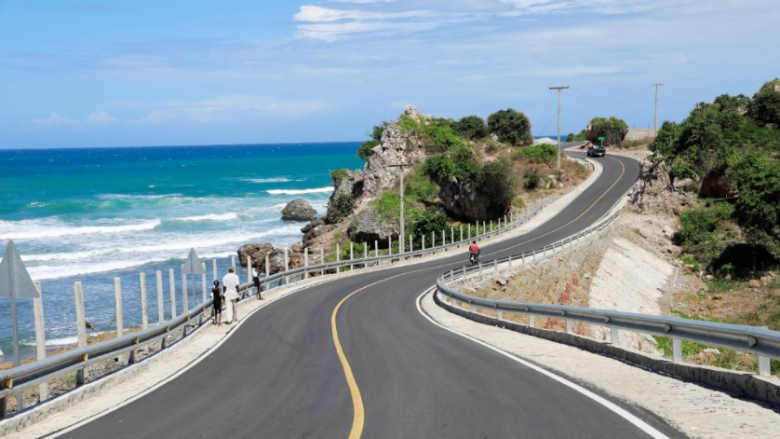Results
IDA financing helped support the achievement of key outcomes, despite the challenging context. These outcomes included:
Restoration of Ministry of Economy and Finance (MEF) internal control and audit functions and, by early 2011, of its ability to process payrolls. By 2012, the capacity of key public financial management (PFM) entities was restored, including budget preparation, tax collection, payroll and salary payment, and external and internal controls; all PFM entities have been back to normal since 2017. The government’s capacity to collect taxes and customs revenues was sustained through the reconstruction and operations of a new antiseismic customs office (2017). The project also supported the government in establishing and operating an institutional framework for properly managing the envisioned PFM reform activities and enhancing the capacities of MEF’s entities.
Rehabilitation of key infrastructures and related activities that benefitted 1.1 million people. These efforts included distribution of immediate recovery supplies to 50,000 people (2010), removal of 110,000 cubic meters of rubble from canals (2010), setting up a debris processing facility, and processing more than 1.3 million cubic meters of rubble (2010 to 2014). In addition, 100 kilometers of road were rehabilitated, including the Cap Haitien to Labadie road, which created tourism potential, improved access to markets and services (June 2016), and generated 95,000 days of work through infrastructure repair or reconstruction, including job opportunities in communities that were among the poorest and most severely affected by the disaster (2017).
Strengthening of the reconstruction planning process for Port-au-Prince and surrounding affected areas and of public consultation mechanisms. The Inter-ministerial Territorial Planning Committee, created only nine months before the earthquake, became one of the major actors in the reconstruction process in 2010, undertaking creation of key transversal development strategies and instruments. The Ministry of Public Works, Transport, and Communications established a Building Technical Evaluation Unit that by 2012 had successfully completed assessments of more than 430,000 buildings. Moreover, during the first half of 2018, more than 16,000 masons and engineers were trained in paraseismic construction.
Bank Group Contribution
In the wake of the 2010 crisis, the World Bank, through the International Development Association, provided US$65 million for the IIERP as a rapid response to the disaster. Thanks to the results delivered by the project, the government requested additional financing in 2012 to scale up activities, which IDA provided in the amount of US$35 million. Another additional financing in the amount of US$2.8 million was subsequently provided in 2016 to finance the design of an effective monitoring plan and baseline data collection.
Partners
The project benefited from the collaboration and coordination of partners, which helped maximize development impact, especially during the project’s emergency phase. The Post-Disaster Needs Assessment was implemented in the first few months following the earthquake using coordinated financial and technical resources provided by IDA, the United Nations, the European Union (EU), and the Inter-American Development Bank (IDB). Continuing their efforts, IDA, EU, and IDB carried out a joint mission in early February 2010 to coordinate with the government on emergency support. Coordination meetings on early recovery actions held with other development partners, including the Sector Coordination Group for Transport, the United States Agency for International Development (USAID), the United States Treasury, and the United States Army Corps of Engineers, the Spanish Aid Agency, the Canadian Agency for International Development, and the French Development Agency, resulted in an effective and efficient preliminary strategy for early, medium, and long-term recovery and reconstruction and valued technical and policy advice to Haiti’s government. This collaboration further strengthened the National Disaster Risk Management System and facilitated coherent and effective implementation of identified activities.
Beneficiaries
The newly paved road linking Cap Haitien to the village of Labadie was inaugurated in February 2018. Merline Pierre lives in Labadie and commutes to Cap Haitien to attend high school. “Many friends of mine have had to move to Cap Haitien because of the road. The trip was too painful, and they were nearly always late. Before the rehabilitation of the road, the trip took more than an hour. The road was in bad condition, with lots of rocks, and passengers would often get sick. Now, with the new road, the trip only takes 20 to 25 minutes.” Jean Oril drives a tap-tap (a large van used for public transportation) and is president of the transport operator union of Labadie. “I have been working on this route for 12 years. I drive people working at Labadie, students, workers.… Before, we could only drive 15 or 16 people and make a maximum of three trips a day. However, with this new road, we can make six to eight trips per day. Prior to the rehabilitation of the road, it was impossible to find a tap-tap after 4 p.m. If one needed to get to the hospital, he or she would have to find her own means of transportation, because there was none available to get you there.”
Moving Forward
The approach of blending early recovery activities with long-term reconstruction planning served as a model for several post-disaster recovery and reconstruction projects subsequently financed by the World Bank. The IIERP enabled IDA to step up its support for Haiti’s recovery efforts and to institutionalize longer-term reconstruction planning. These results and gains are being capitalized, scaled up, and sustained through follow-up operations, including the Statistical Capacity Building Project on the PFM side. On the infrastructure side, improved tourism development prospects provided by the rehabilitated Cap Haitien–Labadie road fit into the ongoing IDA-funded Cultural Heritage Preservation and Tourism Sector Support Project, which capitalizes on such achievements to deliver better results and maximize and sustain impact.

